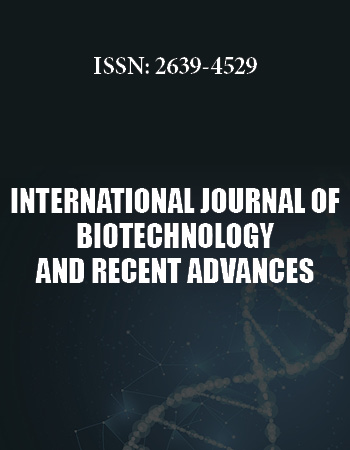Review Article
Plant Tissue Culture, Plant Based Products and Prospects of Commercialization: A Drive from Nature towards Nature
Applied Plant Biotechnology Research Lab, Centre for Plant and Environment Biotechnology Amity Institute of Biotechnology, Amity University, Uttar Pradesh, India
*Corresponding author: Susmita Shukla, Applied Plant Biotechnology Research Lab Centre for Plant and Environment Biotechnology, Amity Institute of Biotechnology, Amity University, Uttar Pradesh, India, E-mail: sshukla3@amity.edu
Received: December 15, 2021 Accepted: December 26, 2021 Published: December 30, 2021
Citation: Shukla S, Thomas S, Bhutani R. Plant Tissue Culture, Plant Based Products and Prospects of Commercialization: A Drive from Nature towards Nature. Int J Biotechnol Recent Adv. 2021; 3(1): 68-73. doi: 10.18689/ijbr-1000112
Copyright: © The Author(s). This work is licensed under a Creative Commons Attribution 4.0 International License, which permits unrestricted use, distribution, and reproduction in any medium, provided the original work is properly cited.
Introduction
The Indian subcontinent represents one of the richest diverse genetic resources. Of the estimated 250,000 species of flowering plants at global level, about 3,000 are regarded as food sources, in which only about 200 species have been domesticated. Global diversity in vegetable crops is estimated at about 400 species, with about 80 species of major and minor vegetables reported to have originated in India. However, with exploitation and overuse of these plant species the diverse genetic resources are declining at a fast pace. Overgrazing, deforestation, and over exploitation of native resources under range situations has exploited biodiversity at certain level which is clearly be observed with change in climate and global warming. Indigenous plant species has not only been source of food but also utilized in pharmaceuticals, nutraceuticals in fact many industries depends on these for its raw materials. The Indian subcontinent has been one of the rich sources of 2,500 plant species used in indigenous treatment and food sources. The present study highlights on important plant species and their use in alleviating hunger, malnutrition and for improving health which will make difference in livelihoods for healthy lifestyle [1]. Plant tissue culture (PTC) and its scope, in India, is an hot topic to talk about. The innovation keeps on beguiling with the advantages of mass multiplication of desired plant variety, germplasm protection, raising disease free plant, somaclonal varieties, proliferation of elite & endangered plants and many more [2]. The micropropagation of food crops for rapid multiplication of in vitro propagation of better cultivars, development of newer cultivars with specific desirable traits, disease-free, quality planting materials which is much on public demand of public in the market. Plant tissue culture technique has a great potential to develop vegetables/crops in large scale to suffice the food demand of growing world populations [3]. Some of the most popular edible plants that are not currently grown on large commercial scales include amaranth, lentils, cassava, chickpeas to name a few which are only sufficient for own consumption and very little to export, These plant species can play a significant role in reducing poverty and malnutrition in various regions around the world if made available in ample amount. Plants can be used to develop natural products like food and oils, but also offer many other products like construction materials or biofuels. To make plants commercially available in large scale, there is need to adapt advance farming which is easy to grow and produce a crop of high quality. The potential for commercialization of plants is always an issue. It can be problematic to find out which plants are actually viable and would be able to provide a sustainable business. Making sure that all the requirements that are needed to do so are met is important, such as making sure there is a market for it and that the plant can produce enough yield to continue production. A recent study in the journal Nature Plants found that “The worldʼs plant species could yield more than US$3 million worth of new pharmaceuticals, for which patents have not yet been filed.” This is because “plants constitute a rich and unexplored source of drugs with enormous potential for discovery,” and they are easier to grow with less lab equipment. Researchers are currently investing in the domestication of new crops that can provide sustainable sources of food. Biodiversity of India, with their extraordinary variety of plant species, represents an extraordinary resource for world agriculture. Investments in research and development on such plant crops are essential to meet the future demands for food, biofuels, and fiber [17].
Keywords: Plant Tissue Culture, Plant Based Products, Commercialization of plants, Nutraceuticals, Agricultural products, Plant Biotechnology

Commercialization of Agricultural product and Market Prospect
Commercialization of agriculture is mainly a process of production of cash crops. A cash crop is simply a crop produced for sale. Agricultural commercialization can be defined as the ‘proportion of agricultural production that is marketed. [4] Commercialization of agriculture involves moving from subsistence- oriented patterns to increasingly market-oriented patterns. The underlying assumption behind this shift is that markets allow households to increase their incomes by producing those commodities that generate the highest returns and then use the cash to buy household consumption items [5]. Recent trends in globalization of smallholder agriculture including connecting smallholder farmers with domestic and international market chains is a clear indication that commercialization of smallholder agriculture will continue to increase in the developing world [6]. Commercialization of smallholder agribusiness by carrying the asset helpless ranchers to business sectors isnʼt completely another peculiarity. The impacts of commercialization on pay, utilization, food security and sustenance are exceptionally perplexing in nature and essentially rely upon family inclinations and intrahousehold allocations [7]. Some of the exogenous elements of commercialization are populace change, reception of new advancements, foundation and market-based turn of events and macroeconomic and exchange approaches. The endogenous elements of commercialization basically rely upon three qualities of intrahousehold navigation: first, the family decides the extent of pay spent on food and non-food (principally wellbeing and sterilization) consumptions. Second, the family decides the allotment of food consumption among the different kinds and amounts of food varieties. Third, the family leader additionally decides how the food and other utilization things are conveyed among the family individuals. Since family food accessibility decides food utilization, assess the effect that commercialization of farming has on family food accessibility. Such an effect can be either sure or negative on the singular individuals from the family relying upon who controls the family pay and how they are dispensed to food utilization and non-food things among the individuals [8]. The complexities involved in commercialization and food consumption are also applicable to the commercialization and nutrition relationship. The nutritional effect of commercialization can be attributed to the impact commercialization has on an individualʼs nutrient intake. [9] The effects of commercialization on childrenʼs welfare are partly mediated through the income–consumption link, since increased incomes are found favorably to affect childrenʼs nutritional status. The effect of commercialization on non-food uses can impact the wellbeing and disinfection climate decidedly which, thus, works on youngstersʼ healthful status. “Commercialization of horticultural frameworks is a widespread and irreversible peculiarity that is set off by monetary development” [10]. The pace of commercialization contrasts across nations and its effect on food security and sustenance is additionally unique. Rural commercialization has complex linkages with food security and nourishment. The relationship works through its impact on family pay, consumptions, and intra household work and asset allotments. The production of commercial crops has been criticized for being unsustainable. For example, some critics say that commercial agriculture promotes the use of pesticides, which are harmful to not just humans but also animals and the environment. The process of commercializing agriculture can be about increasing yield or changing the type of product grown with the use of advance agriculture technologies. The practices of agriculture are an important part of the story of human civilization, with 25,000 yearsʼ worth of history. A farmer had to contend with many risks, challenges, and uncertainties in order to be successful; these include pests, diseases, weeds, changing weather patterns, bad economics for raising certain types of crops or animals due to the cost or availability of feed grains or other raw materials that they need. It is usually grown on a large scale and, for this reason, is not grown to meet food needs. This means that it often does not need to compete with other crops in the marketplace [18].
Different Degrees of Agricultural Commercialization
There are different degrees of agricultural commercialization. They range from the cultivation of food for personal use to large-scale farming which has a significant effect on both the environment and trade.The process of commercialization in the agricultural industry can be broken down into three levels. Level one is when products are sold through local or regional channels. Level two is when products are sold internationally and only through specialized channels. The third level is when products are sold nationally. The degree of commercialization refers to the degree to which something is transformed from its natural state by human activity. There are three main categories of agricultural commercialization in the agricultural industry can be broken down into three levels. Level one is when products are sold through local or regional channels. Level two is when products are sold internationally and only through specialized channels. The third level is when products are sold nationally. The degree of commercialization refers to the degree to which something is transformed from its natural state by human activity. There are three main categories of agricultural commercialization The following are the different levels of agricultural commercialization: -At the first level, farmers sell their crops to middlemen for them to transport, store, and sell. - At the second level, farmers produce crops entirely to feed a commodity market. - At the third level, farmers produce crops entirely for a brandʼs targeted needs mentioned in Table 1 [20].
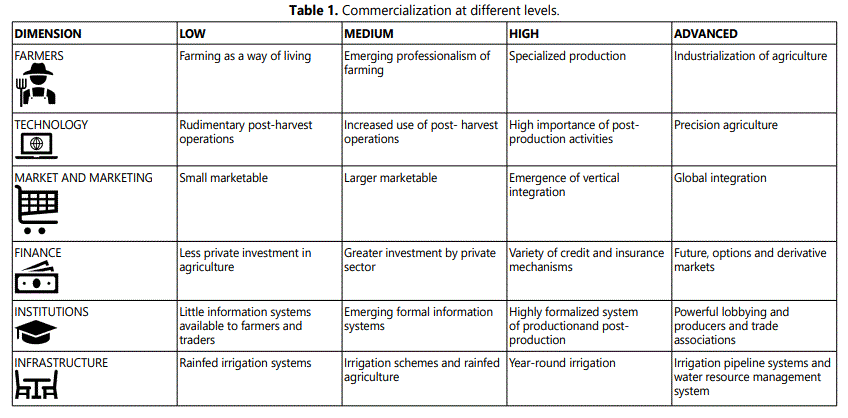
Factors Driving Commercialization
Institutions facilitating commercialization are mechanisms to reduce transaction costs arising from activities such as exchange of goods and financial assets; enforcement of contracts; risk reduction; formation of organizations; and search for and dissemination of information. The institutions reviewed in this section include (i) markets; (ii) contracts; (iii) farmer organizations and trade associations; (iv) standards; (v) formal methods; (vi) monitoring and evaluation; (vii) research and extension; and (viii) credit and insurance. Infrastructure strictly related to commercialization includes agricultural markets and collection centers, irrigation systems, agroindustrial parks, storage facilities and farm-tomarket rural roads. Some of the key issues involved are financing, use, maintenance, management and ownership. In principle, unless there is a clear case for the public good nature of infrastructure there is no scope for public investment. The challenges for agricultural commercialization are various and include reducing the production costs, accelerating innovations, improving capacity to respond to competition, identifying new opportunities and improving the flow of information between different stakeholders (farmers, marketers, processors, exporters). Knowledge management is the capacity to harness the information and knowledge assets available in communities and formal repositories (e.g., research organizations, libraries, internet, reports) and helping farmers, marketers, and enterprises to succeed in their drive towards increased commercialization. For commercialization to thrive, there has to be cooperation among different stakeholders (in order to gain from improved access to technology, credit and markets) and the will to innovate (in order to stay abreast of competition from domestic and international markets). Mechanisms that ensure broad participation and promote initiative on the part of key beneficiaries, including the poor and women, are essential. The overall macro environment is a fundamental factor in facilitating (or hindering) commercialization. Critical aspects for commercialization include economic policies and decentralization[11].
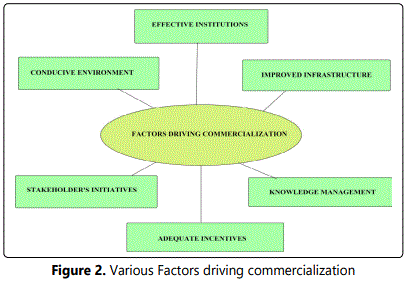
Recent Developments in Agricultural Research
Horticultural development is basic for practical and comprehensive monetary development in India, as by far most of the populace relies upon the rural area for their occupation. Near 60% of Indiaʼs workforce is utilized in horticulture, as indicated by the 2011 registration. Most of landholdings are little. Nearly 82% were delegated limited scope in 2006; and cultivates under two hectares involved 40% of Indiaʼs farming area [12]. Since the Green Revolution period, India has accomplished great development in rural creation, helping public food security and diminishing poverty [13]. India has one of the biggest and all around facilitated public agrarian exploration frameworks on the planet. Its essential organizations are coordinated under the Indian Council of Agricultural Research (ICAR) and state agrarian colleges (SAUs). India has one of the biggest and very much planned agrarian R&D frameworks on the planet.
Agriculture is critical for sustainable and inclusive economic growth in India. In the Indian context, agricultural growth has been a driving force for poverty reduction, more balanced regional economic growth, and improved food security. However, while agriculture has been a key driver of economic growth in recent years, the sector is facing new challenges. First, climate change is impacting crop yields and farmersʼ livelihoods by increasing the frequency of extreme weather events. Second, there are some technological developments in agriculture-from genetically modified seeds to automation-which can potentially wipe out traditional farming practices. Indiaʼs population is expected to reach 1.7 billion by the year 2050 and in order for this number to remain sustainable, there must be equal distribution of food. This is a major issue for India because around 140 million people are involved in agriculture, but it accounts for only 15% of the countryʼs gross value added. In order to reduce poverty and bring about economic growth within India, Indian agricultural research has been working tirelessly to develop farming techniques that preserve natural resources and increase the amount of arable land available. Now more than ever before, agricultural research is critical - from improving productivity to developing climate-smart technologies - for sustainable, inclusive economic growth. The Indian agricultural sector has the potential to transform the lives of millions of smallholder farmers and boost economic growth, but it needs reforms and investments to realize this promise. Given the recent slowdown in agricultural growth in India, it is imperative to take a fresh look at measures to boost productivity and ensure inclusive agricultural growth. The focus should be on increasing investments in agriculture, creating agricultural market opportunities for small producers, improving farm livelihoods and reducing the risks from climate change [19].
Current Research in Plant Biotechnology and Commercial Aspects
Throughout human history, plants have been the object of pervasive and at times dominant artistic and intellectual interest. Plants were important subjects from the earliest study of life processes, and they were central to scientific study in the nineteenth and early twentieth centuries. Plants play an important role to human health. They are the sole source of some of the essential amino acids, vitamins, and other nutrients in our diet. Plants high in ascorbic acid, such as peppers and citrus, prevent scurvy. Grains in the diet provide B vitamins. Research on lower plants and agricultural soils yielded many antibiotics. Even today, many of the prescription drugs are derived from plants. With the research of plants focusing mainly on their medicinal or edible properties, they are often thought to be plants which are merely decorative, meant to make our surroundings more interesting rather than beneficial. There has been an increasing focus on plants as sources of renewable energy and plantbased materials, with many people beginning to understand that they represent a tremendous resource for mankind. There is a long tradition of using plants in art and literature. Plants have been the subject of richly detailed still lives, gardens have been used to depict human emotions and acts, and vegetal motifs have been a staple of everything from poetry to painting [20,21].
Advances in plant biotechnology have been played an important role in large scale production and commercialization of agricultural crops. In vitro studies on various crops has been reported by different scientists such as callus induction from aseptically germinated sorghum seedlings, plant productions from callus cultures of immature healthy embryo of sorghum, genetic improvement of the major cereals such as wheat (Triticum aestivum), rice (Oryza sativa), maize (Zea mays), barley (Hordeum vulgare), sorghum (Sorghum bicolor), millet (Pennisetum sp.), oat (Avena sativa) and rye (Secale cereale) has been particularly important for plant breeders for decades as these crops supply more than half of the food consumed being the major sources of proteins and carbohydrates. These crops are also the basis for production of animal feed oil, starch, flour, sugar, alcoholic beverages, renewable energy, etc[14,15]. Plant tissue culture includes different methods/techniques like embryo culture, anther culture, endosperm culture, protoplast culture, somatic hybridization, synthetic seed production, in vitro secondary metabolite production, micropropagation, cryopreservation, etc.[16]. Agricultural research institutes, public and private Universities and translational research institutions are involved in research on various aspects of crop improvement, plant breeding, in vitro studies etc few of them are listed in Table 2. Applied Plant biotechnology is directly linked to the production and commercialization of plant products. With the sudden drastic emergencies and demand of food production there is an emergent requirement of implementation of advance plant biotechnology techniques which will help to enhance crop production and produce in large scale. Some of the commercial application in form of products has been mentioned in Figure 3 [17,19]. Researchers are now looking into ways to determine if botanical ingredients can be produced sustainably. For example, researchers are looking at the genetic makeup of various plants plant species to ensure that any of the economically important and medicinal plants do not extinct due to over-harvesting and over exploitation. Other studies are investigating the potential benefits of different plants for their ability to produce natural antibiotics and other phytochemicals which can be used as pharmaceuticals or supplements for man purpose. The recent research on various plant species potential for commercialization are being carried out as an effort to provide a comprehensive database on the production of natural products/medicines, which are very important for sustainable development.
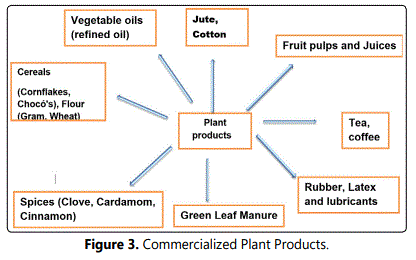
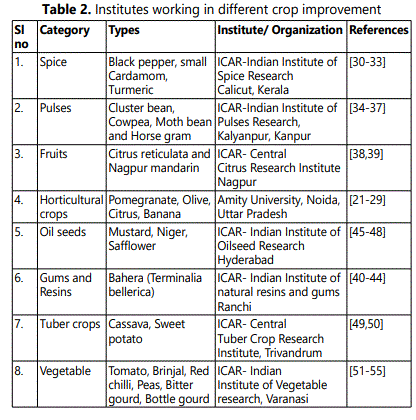
Conclusion
Current research focusing on the environmental and economic benefits of various plant species are mainly for food, pharmaceuticals, and chemical production. Researchers are investigating Natural plant based products which may be best suited for commercialization based on their traits, such as yield, drought tolerance, pest resistance, oil content, nutritional value etc. There are much more to be learned about the potential of various plant species which are commercially viable. Plant Tissue culture, Gene editing, Artificial intelligence are the thrust area which has potential to fill the gap in anticipated food need of the people with enhanced expected population worldwide.
Acknowledgement
The authors are grateful to the Amity University, Uttar Pradesh for facilitating us with the infrastructure and laboratory facilities for manifesting this research work.
References
- Chadha M L. Indigenous vegetables of India with potentials for improving livelihood. Acta Hortic. 2009; 806: 579-586. doi: 10.17660/ActaHortic.2009.806.72
- Pant M, Mehta R. The Economics of plant tissue culture: An Indian Perspective. Asian Journal of pharmaceutical and clinical research. 2016; 9(3): 36-37.
- Ragavendran C, Natarajan D. Role of Plant Tissue Culture for Improving the Food Security in India: A Review Update. Sustainable Agriculture towards Food Security. 2017; 231-262. doi: 10.1007/978-981-10-6647-4_13
- Govereh J, Jayne T S. Effects of cash crop production on Food crop productivity in Zimbabwe: Synergies or trade-offs? Food Security International Development Working Papers. 1999; doi: 10.22004/ag.econ.54670
- Timmer C Peter. Farmers and markets: The political economy of new paradigms. American journal of agricultural economics. 1997; 79(2): 621-627.
- Von Braun J. The world food situation: new driving forces and required actions. Intl Food Policy Res Inst. 2007; doi: 10.2499/0896295303
- Von Braun J, Kennedy E T. Agricultural commercialization, economic development, and nutrition. International Food Policy Research Institute by Johns Hopkins University Press; 1994.
- Quisumbing A R, Maluccio J A. Intrahousehold allocation and gender relations: New empirical evidence from four developing countries. International Food Policy Research Institute; 2000.
- Paredes M, Cole D C, Boada L, Berti P R. Assessing responsible food consumption in three Ecuadorian city regions. 1st Edition. Sustainable Food System Assessment; 2019.
- Suresh C B, Prabuddha S. Food security, poverty and nutrition policy analysis. Statistical Methods and Applications; 2009.
- Lowder S K, Skoet J, Singh S. What do we really know about the number and distribution of farms and family farms in the world? Background paper for The State of Food and Agriculture; 2014.
- Fan S, Gulati A, Thorat S. Investment, subsidies, and pro-poor growth in rural India. Agricultural Economics. 2008; 39(2): 163-170. doi: 10.1111/j.1574-0862.2008.00328.x
- Beintema N, G J Stads. Public agricultural R&D investments and capacities in developing countries: Recent evidence for 2000 and beyond. Background note for the Global Conference on Agricultural Research for Development, Montpellier, France; 2010.
- FAO (2013). Food and Agricultural Organization. Cited April 27, 2015.
- Snow A A, Palma P M. Commercialization of transgenic plants: potential ecological risks. BioScience. 1997; 47(2): 86-96.
- Sher H, Alyemeni M N. Cultivation and domestication study of high value medicinal plant species (its economic potential and linkages with commercialization). African Journal of Agricultural Research. 2010; 5(18): 2462-2470.
- Jeelani S M, Rather G A, Sharma A, Lattoo S K. In perspective: Potential medicinal plant resources of Kashmir Himalayas, their domestication and cultivation for commercial exploitation. Journal of Applied Research on Medicinal and Aromatic Plants. 2018; 8: 10-25. doi: 10.1016/j.jarmap.2017.11.001
- Droby S, Wisniewski M, Teixidó N, Spadaro D, Jijakli M H. The science, development, and commercialization of postharvest biocontrol products. Postharvest Biology and Technology. 2016; 122: 22-29. doi: 10.1016/j.postharvbio.2016.04.006
- Raman T, Gupta VS, Shukla S. A robust micropropagation protocol for genetically true to type plants of Phule Arakta pomegranate. Indian Journal of Horticulture. 2019; 76(1): 23-31. doi: 10.5958/0974-0112.2019.00004.5
- Ritupriya Singh, Ruchi Verma, Susmita Shukla. Phytochemical Screening of Secondary Metabolites present in Fruit peels, Ex-vitro and In-vitro leaf extract of Citrus macropteramontr.: An important crop with medicinal nutritional value. International Journal of Tropical Agriculture. 2019; 37(2): 127-131.
- Subhankar Das, Vishal Gupta, Manjula I Kalyani, Mohan Chandra Kalita, Susmita Shukla. Biological synthesis and characterization of silver nanoparticles using stem extract of Langenaria siceraria and their antibacterial activity against Escherichia coli and Staphylococcus aureus. Biomedicine. 2019; 39(4): 580-586. doi: 10.51248/.v39i4.137
- Ritambhara Bhutani, ShivKant Shukla, Susmita Shukla. Impact of Sterilants on Culture Establishment of Indigenous Musa L. Varieties: A Step f orward for Conservation, Environmental Science and Pollution Research. Environ Sci Pollut Res Int. 2021; 28(4): 3913-3919. doi: 10.1007/s11356-020-10059-w
- Shiv Kant Shukla, Anmol S Verma, Manfred Miheso, Susmita Shukla. Indo-Kenyan collaborative approach and potential for commercialization of plant tissue culture. Bionature. 2020; 40(2): 52-65.
- Subhankar Das, Rantumoni Sharma, Manjula I Kalyani, Namita Nath, M C Kalita, Susmita Shukla. Sunlight driven biosynthesis of silver nanoparticles using aqueous stem extract of Tinospora sinensis (Lour.) Merr. and evaluation of its catalytic and antibacterial activity. Biomedicine. 2020; 40(3): 301-308. doi: 10.51248/.v40i3.14
- Sandhya Sharma, Susmita Shukla. A Review on Regeneration Potential and Commercialization of Azadirachta Indica: A Multifunctional Tree Species. Agrica. 2020; 9(2): 101-111. doi: 10.5958/2394-448X.2020.00014.0
- Ayushi Tripathi, Samir Debnath, Susmita Shukla. Review on Biotechnological advances in Vigna radiata and their future prospects. Journal of Crop Science and Biotechnology. 2021; 24: 245-258. doi: 10.1007/s12892-021-00086-5
- Alagupalamuthirsolai M , Ankegowda S J, Sharon Aravind. Factors determining the midday depression of photosynthesis in small cardamom (Elettaria cardomum Maton) under summer climate. Multilogic in Science. 2018; (7): 525-528.
- R Senthil Kumar, D Prasath, Sharon Aravind, N K Leela, M N Venugopal, S J Ankegowda, et al. Evaluation of elite cardamom (Elettaria cardamomum) genotypes for yield, quality and resistance to Cardamom mosaic virus. Journal of Plantation Crops. 2017; 45(2): 129-134.
- M R Ahuja and S M Jain. Genetic Diversity and Erosion in Plants Indicators and Prevention. Sustainable Development and Biodiversity; 2015.
- R K Varshney, Thudi M, Roorkiwal M, Dixit G P, Xin Liu, et al. Resequencing of 429 chickpea accessions from 45 countries provides insights into genome diversity, domestication and agronomic traits. Nature Genetics. 2019; 51: 857–864. doi: 10.1038/s41588-019-0401-3
- Dixit G P, Parihar A K, Bohra A, Singh N P. Achievements and prospects of grass pea (Lathyrus sativus L.) Improvement for sustainable food production. The Crop Journal. 2016; 4(5): 407-416. doi: 10.1016/j.cj.2016.06.008
- Gaur P M, Dixit G P. Integrated breeding approaches for improving drought and heat adaptation in chickpea (Cicer arietinum L). Plant Breeding. 2014; 138(4): 389-400. doi: 10.1111/pbr.12641
- Manish Roorkiwal, Dixit G P, Rajeev K Varshney, et al. Integrating genomics for chickpea improvement: achievements and opportunities. Theoretical and Applied Genetics. 2020; 133: 1703-1720. doi: 10.1007/s00122-020-03584-2
- Kumar D, Ladaniya M S, Gurjar M. Underutilized Citrus sp. Pomelo (Citrus grandis) and Kachai lemon (Citrus jambhiri) exhale in phytochemicals and antioxidant potential. Journal of Food Science and Technology. 2019; 56(1): 217-223. doi: 10.1007/s13197-018-3477-3
- Kumar D, Ladaniya M S, Gurjar M, Mendke S, Kumar S. Integrated Membrane Process for the Production of Nagpur Mandarin (Citrus reticulata Blanco) Juice Concentrate: Impact on Nutritional Content and Antioxidant Activity. International Journal of Innovative Horticulture. 2019; 8(2): 127-134. doi: 10.5958/2582-2527.2019.00006.X
- Chowdhury AR, Gupta RL. Synthesis and fungi-toxicity evaluation of Schiff bases of 4-amino3-mercapto-5-phenyl-1,2,4-triazole. Int J Chem Stud. 2019; 7(6): 3-8.
- Ghosal S, Meena SC. Factors affecting lac insect settlement. Ind J For. 2019; 145(12): 1212-1213.
- Kandasamy T, Roy T, Mohanasundaram A, Sharma KK, Ramani R. 18S rDNA based detection of hymenopteran parasitoids in the Indian lac insect, Kerria lacca (Kerr). Ind J Exp Biol. 2019; 57: 526-531.
- Kumari K, Thamilarasi K, Ghosh J, Lohot VD, Ghosal S. Molecular diversity analysis of pigeonpea genotypes for scar marker development. Int J Chem Stud. 2019; SP6: 534-540.
- Lohot VD, Ghosh J, Thamilarasi K, Mohanasundaram A, et al. Explicating the impact of phloem sap sucking lac insect (Kerria lacca Kerr) on phytochemistry of Kusum (Schleichera oleosa Oken.) host. Int J Chem Stud. 2019; 7(6): 142-147.
- Aher S B, Brijlal Lakaria, Singh A B, Swami Kaleshananda, Ramana S, Ramesh K, et al. Effect of organic sources of nutrients on performance of soybean (Glycine max). Indian Journal of Agricultural Sciences. 2019; 89(11): 1787-1791.
- Anjani K, Mandalapu P, Ponukumatla B, Prasad R D, Sarada C. Introgression of resistance to Alternaria leaf spot from wild species into susceptible cultivated safflower. Plant Breeding. 2019; 139(2): 1-7. doi: 10.1111/pbr.12775
- Bhakta R S, Lodam VA, Chauhan DA, Patel DA, Patel VM, et al. GNCH-1: a high yielding, wilt and leafhopper resistant castor hybrid suitable for Gujarat. Journal of Oilseeds Research. 2018; 35(2): 109-115.
- Chandrika KSVP, Prasad RD, Varsha G. Development of chitosan-PEG blended films using Trichoderma: Enhancement of antimicrobial activity and seed quality. International Journal of Biological Macromolecules. 2019; 126: 282-290. doi: 10.1016/j.ijbiomac.2018.12.208
- Chithra S, Susan John K, Sreekumar J. Low cost traditional cassava starch factory solid waste (thippi) composting: a possible strategy for organic nutrient management and economic security for tribal farmers. Journal of Root Crops. 2016; 42(2): 52- 58.
- Roy Shubhadeep, Singh Neeraj, Vanitha SM, Rai AB, Naik PS. E-Survey to analyse perception of agricultural experts regarding priority setting for future research in vegetables in India. Proc Natl Sci India Sect B Biol Sci. 2015; 86(4): 1009-1016. doi: 10.1007/s40011-015-0562-5
- Singh Neeraj, Roy Shubhadeep, Rai AB, Singh B. Garden pea harnessing high remuneration leads to livelihood security in eastern Uttar Pradesh. Vegetable Science. 2014; 41(1): 19-21.
- Roy Shubhadeep, Singh Baldeo, Padaria R N, Singh Neeraj. Grass Root Constrictions in Implementation of MNREGA in West Bengal. Indian Journal of Extension Education. 2014; 50(1-2): 24-27.
- Roy Shubhadeep, Singh Baldeo, Padaria RN, Singh Neeraj. Activities and Institutional Mechanism of MNREGA and its Effectiveness in West Bengal. Indian Journal of Extension Education. 2014; 50(1-2): 18-23.

